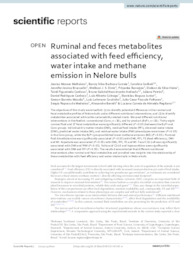Ruminal and feces metabolites associated with feed efciency, water intake and methane emission in Nelore bulls.
Ruminal and feces metabolites associated with feed efciency, water intake and methane emission in Nelore bulls.
Autoria: MALHEIROS, J. M.; CORREIA, B. S. B.; CERIBELI, C.; BRUSCADIN, J. J.; DINIZ, W. J. S.; BANERJEE, P.; VIEIRA, D. S.; CARDOSO, T. F.; ANDRADE, B. G. N.; PETRINI, J.; CARDOSO, D. R.; COLNAGO, L. A.; BOGUSZ JUNIOR, S.; MOURÃO, G. B.; COUTINHO, L. L.; PALHARES, J. C. P.; MEDEIROS, S. R. de; BERNDT, A.; REGITANO, L. C. de A.
Resumo: The objectives of this study were twofold: (1) to identify potential diferences in the ruminal and fecal metabolite profles of Nelore bulls under diferent nutritional interventions; and (2) to identify metabolites associated with cattle sustainability related-traits. We used diferent nutritional interventions in the feedlot: conventional (Conv; n= 26), and by-product (ByPr, n= 26). Thirty-eight ruminal fuid and 27 fecal metabolites were signifcantly diferent (P< 0.05) between the ByPr and Conv groups. Individual dry matter intake (DMI), residual feed intake (RFI), observed water intake (OWI), predicted water intake (WI), and residual water intake (RWI) phenotypes were lower (P< 0.05) in the Conv group, while the ByPr group exhibited lower methane emission (ME) (P< 0.05). Ruminal fuid dimethylamine was signifcantly associated (P< 0.05) with DMI, RFI, FE (feed efciency), OWI and WI. Aspartate was associated (P< 0.05) with DMI, RFI, FE and WI. Fecal C22:1n9 was signifcantly associated with OWI and RWI (P< 0.05). Fatty acid C14:0 and hypoxanthine were signifcantly associated with DMI and RFI (P< 0.05). The results demonstrated that diferent nutritional interventions alter ruminal and fecal metabolites and provided new insights into the relationship of these metabolites with feed efciency and water intake traits in Nelore bulls.
Ano de publicação: 2023
Tipo de publicação: Artigo de periódico
Unidade: Embrapa Instrumentação
Palavras-chave: Diferent nutritional interventions, Fecal microbiomes
Observações
1 - Por padrão são exibidas publicações dos últimos 20 anos. Para encontrar publicações mais antigas, configure o filtro ano de publicação, colocando o ano a partir do qual você deseja encontrar publicações. O filtro está na coluna da esquerda na busca acima.
2 - Para ler algumas publicações da Embrapa (apenas as que estão em formato ePub), é necessário ter, no celular ou computador, um desses softwares gratuitos. Sistemas Android: Google Play Livros; IOS: iBooks; Windows e Linux: software Calibre.
Acesse outras publicações
Acesse a Base de Dados da Pesquisa Agropecuária (BDPA) para consultar o acervo completo das bibliotecas da Embrapa.

